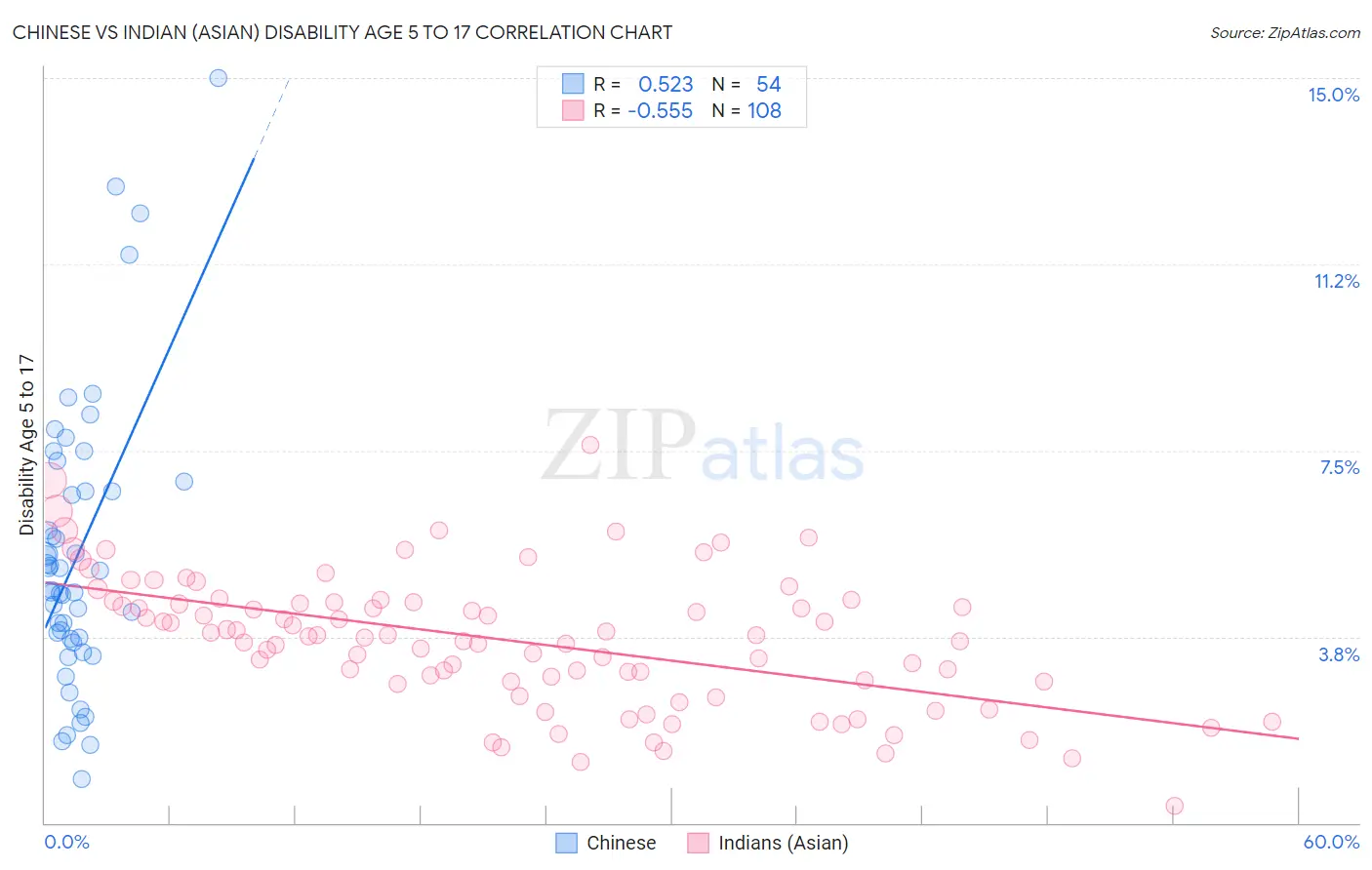Chinese vs Indian (Asian) Disability Age 5 to 17
COMPARE
Chinese
Indian (Asian)
Disability Age 5 to 17
Disability Age 5 to 17 Comparison
Chinese
Indians (Asian)
4.7%
DISABILITY AGE 5 TO 17
100.0/ 100
METRIC RATING
15th/ 347
METRIC RANK
4.6%
DISABILITY AGE 5 TO 17
100.0/ 100
METRIC RATING
8th/ 347
METRIC RANK
Chinese vs Indian (Asian) Disability Age 5 to 17 Correlation Chart
The statistical analysis conducted on geographies consisting of 64,726,058 people shows a substantial positive correlation between the proportion of Chinese and percentage of population with a disability between the ages 5 and 17 in the United States with a correlation coefficient (R) of 0.523 and weighted average of 4.7%. Similarly, the statistical analysis conducted on geographies consisting of 488,980,607 people shows a substantial negative correlation between the proportion of Indians (Asian) and percentage of population with a disability between the ages 5 and 17 in the United States with a correlation coefficient (R) of -0.555 and weighted average of 4.6%, a difference of 2.8%.

Disability Age 5 to 17 Correlation Summary
| Measurement | Chinese | Indian (Asian) |
| Minimum | 0.88% | 0.35% |
| Maximum | 15.0% | 7.6% |
| Range | 14.1% | 7.3% |
| Mean | 5.4% | 3.7% |
| Median | 4.9% | 3.8% |
| Interquartile 25% (IQ1) | 3.7% | 2.8% |
| Interquartile 75% (IQ3) | 6.7% | 4.4% |
| Interquartile Range (IQR) | 3.0% | 1.6% |
| Standard Deviation (Sample) | 2.9% | 1.3% |
| Standard Deviation (Population) | 2.8% | 1.3% |
Demographics Similar to Chinese and Indians (Asian) by Disability Age 5 to 17
In terms of disability age 5 to 17, the demographic groups most similar to Chinese are Immigrants from Korea (4.7%, a difference of 0.20%), Immigrants from Singapore (4.7%, a difference of 0.42%), Arapaho (4.7%, a difference of 0.88%), Immigrants from South Central Asia (4.7%, a difference of 0.90%), and Thai (4.7%, a difference of 0.91%). Similarly, the demographic groups most similar to Indians (Asian) are Immigrants from Eastern Asia (4.6%, a difference of 0.33%), Immigrants from India (4.6%, a difference of 0.40%), Armenian (4.6%, a difference of 0.56%), Iranian (4.6%, a difference of 0.80%), and Immigrants from China (4.5%, a difference of 0.93%).
| Demographics | Rating | Rank | Disability Age 5 to 17 |
| Immigrants | Armenia | 100.0 /100 | #1 | Exceptional 4.1% |
| Immigrants | Taiwan | 100.0 /100 | #2 | Exceptional 4.2% |
| Immigrants | Hong Kong | 100.0 /100 | #3 | Exceptional 4.3% |
| Filipinos | 100.0 /100 | #4 | Exceptional 4.3% |
| Immigrants | Iran | 100.0 /100 | #5 | Exceptional 4.4% |
| Immigrants | Israel | 100.0 /100 | #6 | Exceptional 4.5% |
| Immigrants | China | 100.0 /100 | #7 | Exceptional 4.5% |
| Indians (Asian) | 100.0 /100 | #8 | Exceptional 4.6% |
| Immigrants | Eastern Asia | 100.0 /100 | #9 | Exceptional 4.6% |
| Immigrants | India | 100.0 /100 | #10 | Exceptional 4.6% |
| Armenians | 100.0 /100 | #11 | Exceptional 4.6% |
| Iranians | 100.0 /100 | #12 | Exceptional 4.6% |
| Thais | 100.0 /100 | #13 | Exceptional 4.7% |
| Immigrants | Korea | 100.0 /100 | #14 | Exceptional 4.7% |
| Chinese | 100.0 /100 | #15 | Exceptional 4.7% |
| Immigrants | Singapore | 100.0 /100 | #16 | Exceptional 4.7% |
| Arapaho | 100.0 /100 | #17 | Exceptional 4.7% |
| Immigrants | South Central Asia | 100.0 /100 | #18 | Exceptional 4.7% |
| Immigrants | Uzbekistan | 100.0 /100 | #19 | Exceptional 4.8% |
| Burmese | 100.0 /100 | #20 | Exceptional 4.8% |
| Yup'ik | 100.0 /100 | #21 | Exceptional 4.8% |